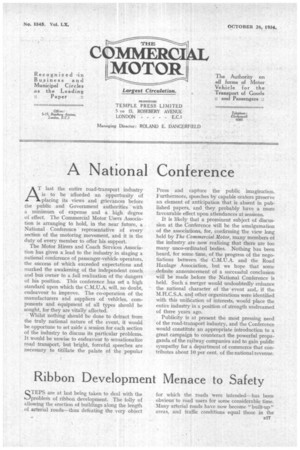Ribbon Development Menace to Safety
Page 31

Page 32

If you've noticed an error in this article please click here to report it so we can fix it.
STEPS are at last being taken to deal with the /problem of ribbon development. The folly of allowing the erection of buildings along the length of arterial roads—thus defeating the very object for which the roads were intended—has been obvious to road users for some considerable time. Many arterial roads have now become " built-up" areas, and traffic conditions equal those in the towns, with a consequent increase in the number of accidents and a heavy addition to the number of killed and injured in such occurrences.
The counties of Surrey, Middlesex and Essex have recently obtained powers giving them the right to restrict ribbon development on roads under their jurisdiction, and the British Road Federation has now prepared a memorandum, containing proposals for immediate action, which it is to submit to the Minister of Transport.
Briefly, the proposal of the B.R.F. is that the powers obtained by the authorities mentioned should be conferred upon every county council in the country by means of general legislation. By this means the power would be available, to local authorities, to prohibit all building within 200 ft. of any scheduled road, or compulsorily to purchase land for 220 yds. on each side of the road. Landowners would be subject to compensation, and should they desire to develop their properties, the buildings would be required to be well back from the main roads. Further points in the memorandum refer to improvements of arterial roads already marred by buildings.
In view of the statements made recently by the Minister on the subject of new roads, and reported in our issue dated October 19, it is to be hoped that this important aspect of the road problem will receive careful attention.
Modern Appliances Essential to Efficient Maintenance
AMONG engineers responsible for the maintenance of fleets of commercial vehicles, we have sometimes observed a tendency to adhere to the methods of their apprenticeships. Efficient repairing and servicing, according to modem standards, demand modem equipment, and the really creditable work that is continually being done by the makers thereof deserves full support.
The rough-and-ready methods employed by "half-inch fitters" waste time and cost money. There are tools and appliances for the quick and precise accomplishment of almost every operation involved in automobile servicing and overhauling, whilst man-power is more expensive in the long run than any of the many forms of energy to-day available for workshop use.
A review of the new garage equipment on view last week at the Motor Show appeared in The Commercial Motor dated October 19, and its careful perusal, even by those who were able to make an examination of the actual exhibits, should have proved of great value to all maintenance engineers, however wide their experience. Discriminating expenditure in bringing the garage equipment up to date is an investment that will assuredly show handsome profit.




























































































